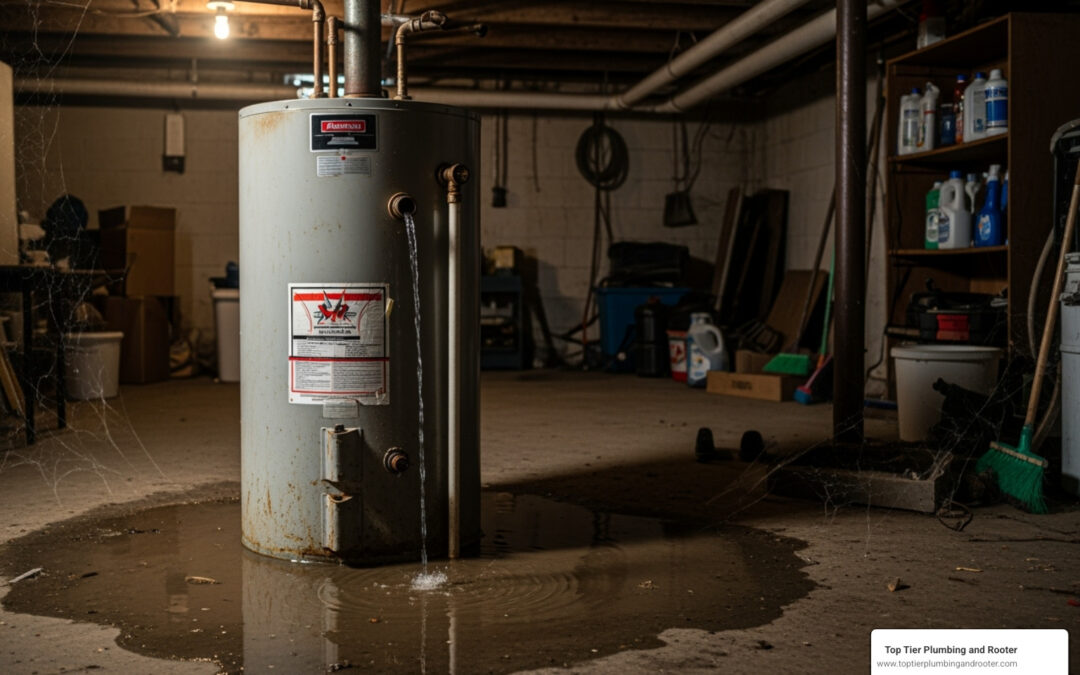Why Your Broken Water Heater Doesn’t Have to Ruin Your Day
A broken water heater fix can seem overwhelming, but many issues are simple to diagnose and resolve. Nothing ruins your day quite like a cold shower or finding a puddle around your water heater.
Quick Fix Checklist for Broken Water Heaters:
- No Hot Water – Check circuit breaker or pilot light first
- Not Enough Hot Water – Flush tank to remove sediment buildup
- Strange Noises – Usually indicates sediment accumulation requiring tank flushing
- Leaking Water – Tighten loose connections or replace faulty drain valve
- Rusty/Smelly Water – May need anode rod replacement or professional inspection
The good news is that sediment buildup, the most common cause of water heater failure, is often a DIY fix. Many repairs take less than an hour and require no special skills.
Before calling for an expensive replacement, follow our guide to diagnose the problem. You’ll learn to identify if it’s a simple DIY fix or needs professional help.
As one homeowner found: “When a water heater isn’t heating or has other problems, you may be able to fix it by yourself. The repair might be as simple as adjusting a setting, pressing a reset button, or clearing sediment buildup.”
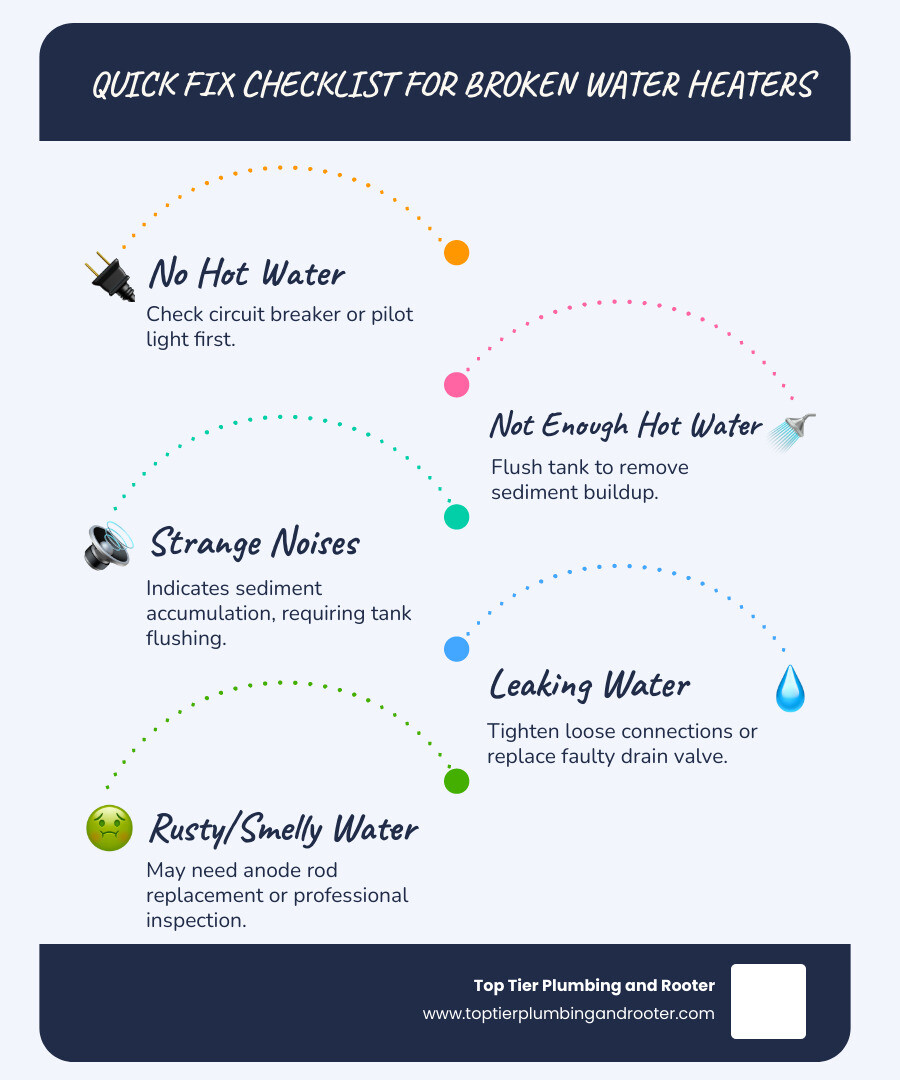
First Signs of Trouble: Is Your Water Heater Broken?
Your water heater rarely fails without warning. Recognizing the early signs can save you from a cold shower and help you tackle a broken water heater fix before it becomes an emergency.
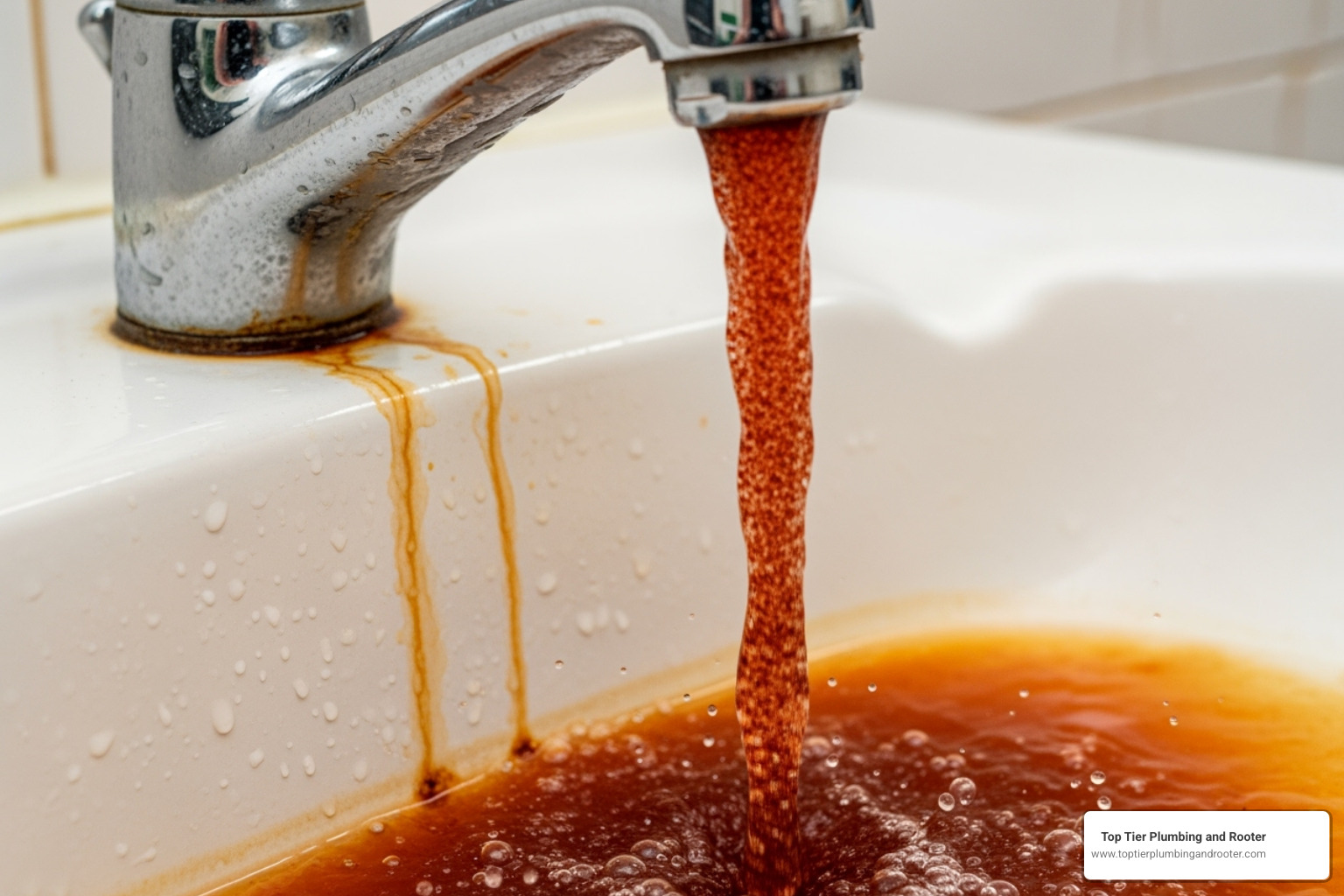
No Hot Water or Not Enough
A blast of cold water instead of a warm shower is a clear sign of trouble. If you have lukewarm showers or tepid water, your water heater needs attention.
When there’s no hot water at all, it’s likely a power issue. For electric units, check for a tripped circuit breaker or blown fuse. Gas water heaters might have an extinguished pilot light or thermostat issues.
If you’re getting some hot water but not enough, this often points to sediment buildup. Over time, minerals from your water settle at the bottom of the tank, creating an insulating layer that forces your heating elements to work overtime. Other possibilities include an undersized unit that can’t meet your family’s demands or failed heating elements that need replacement.
Strange Noises: Popping, Rumbling, or Banging
Don’t ignore popping, rumbling, or banging sounds. This is your water heater telling you something is wrong.
The usual culprit is sediment buildup. As water gets trapped under mineral deposits, it creates steam bubbles that pop and rumble as they escape. This overheating occurs because the heating elements work harder to heat water through the sediment. You’re hearing boiling water in the tank, which harms your unit and increases energy bills.
Regular maintenance can prevent these mineral deposits from forming. For detailed guidance, check out our guide to water heater maintenance.
Discolored or Smelly Water
Seeing rusty water from your hot tap is a serious sign. This discoloration usually means there’s corrosion inside your tank. Your water heater has a sacrificial anode rod designed to corrode instead of the tank. When it fails, anode rod failure leaves your tank vulnerable to rust.
A rotten egg smell in your hot water typically indicates bacteria in the tank, which is common in wells or units that haven’t been used recently. While not usually dangerous, it’s unpleasant.
These water quality issues need prompt attention. For more information on water odors, you can learn more about understanding odors in your water.
Visible Leaks or Puddles
A puddle around your water heater demands immediate attention. Visible leaks can be minor or major emergencies, depending on their source.
Leaking valves are often easy fixes. A drain valve or temperature and pressure relief valve might be loose or faulty. Damaged connections between pipes can usually be tightened or resealed.
A more serious concern is tank corrosion. If water is seeping from the tank itself, it’s likely due to internal corrosion that can’t be repaired. Your pressure relief valve might also be working overtime if there’s too much pressure in the system.
Even small leaks pose a water damage risk. Address any leak quickly to prevent costly damage to your home.
Your Guide to a DIY Broken Water Heater Fix
Ready to tackle your water heater? Many problems can be solved with basic troubleshooting, no professional experience needed.
Safety first! Always turn off the power or gas supply to your unit before attempting any repairs.
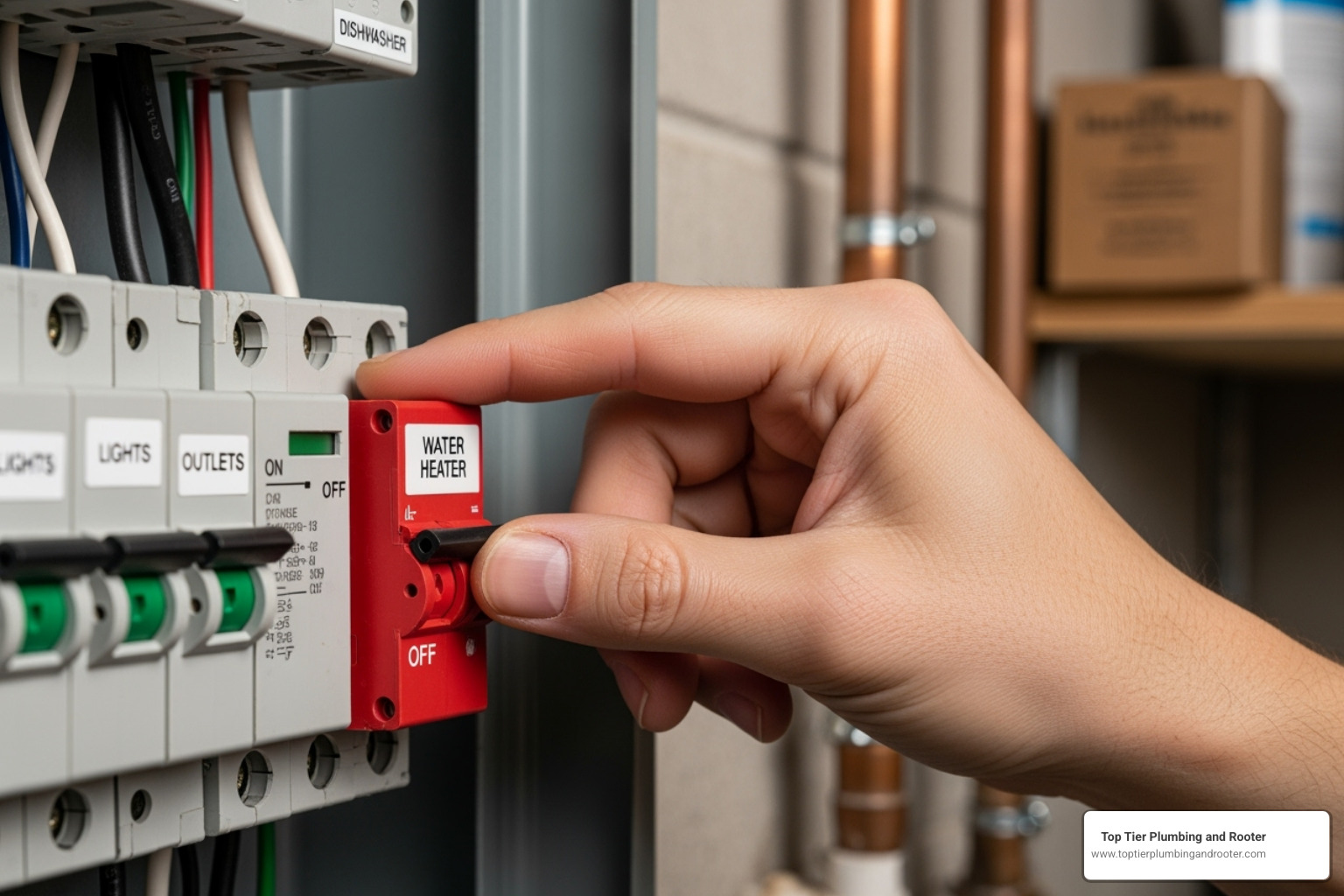
Step 1: Check the Power or Gas Supply
It sounds simple, but checking the power or gas supply is often the key to a broken water heater fix. Many “broken” units just need their power restored.
For electric water heaters, go to your electrical panel and look for a tripped circuit breaker. A tripped breaker will be in the “off” or a middle position. Flip it completely off, then firmly back on. If it trips again, you have an electrical issue that needs a professional. Also, press the red reset button, usually found near the thermostat behind an access panel. A click often means the problem is solved.
For gas water heaters, ensure the gas supply valve is open. Then, check if the pilot light is out. If so, follow the lighting instructions on the unit’s label. This usually involves turning the gas control knob to “pilot,” pressing it down, and lighting it. If the pilot won’t stay lit, the thermocouple (a safety sensor) may be faulty.
Step 2: Address Temperature Problems
If your water temperature is inconsistent, the thermostat is the likely culprit.
If your water is scalding hot, it’s dangerous. Electric units have two thermostats (upper and lower) that should be set to the same temperature, ideally 120°F, to prevent scalding and save energy. Adjust with a flat-blade screwdriver. If that fails, the thermostat may be defective.
For inconsistent or not-hot-enough water, check your thermostat settings. If they are correct, you could have a failing heating element or sediment buildup.
To test a thermostat, follow these steps:
- Turn off the power to the water heater.
- Remove the access covers and insulation.
- Adjust the thermostat dial from its highest to lowest setting.
- Listen for an audible click at each end. If you don’t hear a click, the thermostat likely needs to be replaced.
Step 3: Handle Minor Leaks
Small leaks can be scary, but many are simple fixes once you find the source.
A leaking drain valve at the bottom of the tank can often be fixed by opening it to flush out debris, then closing it tightly. If it still drips, the valve needs to be replaced.
The temperature and pressure (T&P) relief valve is a key safety feature. If it drips constantly, the tank pressure might be too high (check the thermostat) or the valve is faulty. Check the thermostat first; if it still leaks, replace the valve. Do not ignore this.
Loose pipe connections are an easy fix. Check all plumbing connections and tighten them with a wrench. For stubborn leaks, use Teflon tape on the threads before reconnecting.
While some leaks are minor, others can become serious. If water is coming from the tank itself or a drip becomes a stream, you may have an emergency situation.
Step 4: Flush the Tank to Remove Sediment
Flushing your tank removes sediment, the most common cause of water heater failure. This annual task can fix noisy operation and improve heating.
The flushing process begins by turning off the cold water supply and the power (or setting gas to “pilot”). Attach a garden hose to the drain valve and run it to a floor drain or outside.
Open a hot water faucet in the house to let air in, then open the drain valve. You’ll likely see cloudy, sediment-filled water.
Once the tank is empty, briefly open the cold water supply to stir up remaining sediment, then let it drain again. Repeat until the water runs clear.
To finish, close the drain valve, remove the hose, and close the hot water faucet. Turn the cold water supply back on to refill the tank. Once full, restore power or gas.
Gas vs. Electric & Tank vs. Tankless: How Repairs Differ
For a broken water heater fix, knowing your system type is crucial. Like a gas vs. electric car, the underlying problems differ even if symptoms seem similar.
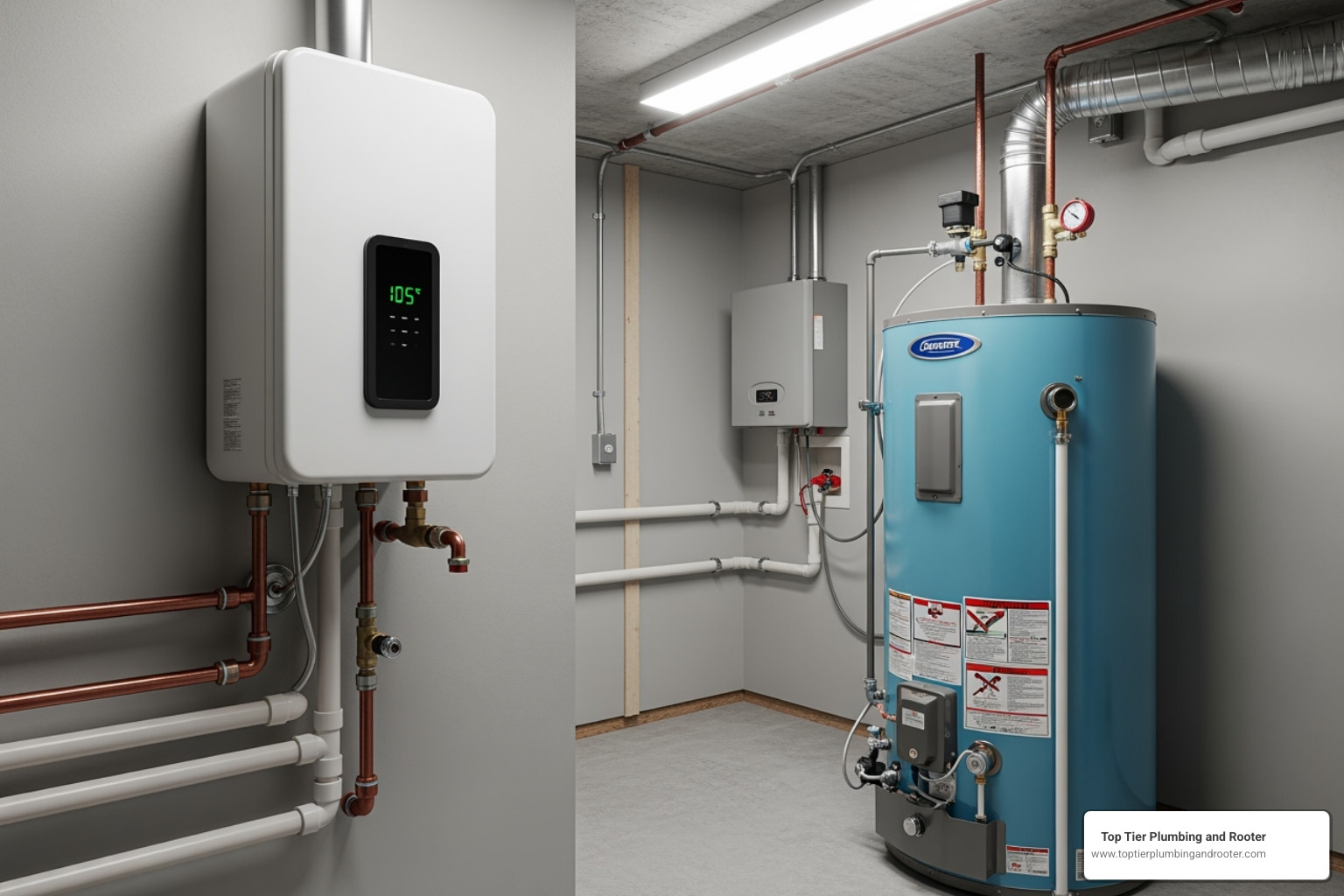
Gas vs. Electric Water Heaters
The main difference is how they create heat, which affects all troubleshooting.
Gas water heaters use a pilot light and burner. Common issues involve the pilot light going out, a faulty thermocouple (the flame sensor), a bad gas valve, or venting problems.
Electric water heaters use heating elements and thermostats. Failures are often due to a tripped circuit breaker, a burned-out heating element, or a bad thermostat. Electric units lack pilot lights but have electrical connections that can corrode.
Gas units typically heat water faster, but electric units are often easier for homeowners to troubleshoot safely.
Tank vs. Tankless Water Heaters
The difference between tank and tankless systems is storage vs. on-demand heating.
Traditional tank water heaters store 30-80 gallons of hot water. They have a sacrificial anode rod to prevent tank rust and are prone to sediment buildup, which causes popping sounds. When tank corrosion occurs after the anode rod fails, you’ll see rusty water.
Tankless water heaters heat water instantly as it passes through a heat exchanger. They are more complex, with flow sensors and computer controls. The main enemy of tankless units is mineral scaling from hard water, which clogs the heat exchanger.
| Issue Type | Tank Systems | Tankless Systems |
|---|---|---|
| No Hot Water | Check pilot light, heating elements, or thermostats | Look for ignition problems, flow sensor issues, or mineral scaling |
| Strange Noises | Usually sediment buildup causing popping sounds | Often scaling in heat exchanger or fan motor issues |
| Water Quality | Rusty water from failed anode rod or tank corrosion | Scaling can cause metallic taste or reduced flow |
| Leaks | Tank corrosion, valve problems, or loose connections | Usually connection issues or heat exchanger problems |
| Lifespan | 8-12 years with proper maintenance | 20-25 years with regular descaling |
Tank systems need annual flushing and regular anode rod checks. Tankless units require periodic descaling, especially with hard water. The complexity of tankless systems often requires professional repair, while tank systems are more DIY-friendly. If you’re considering an upgrade, you can learn about tankless water heaters and their advantages.
Repair or Replace? Knowing When a Fix Isn’t Enough
Sometimes, a broken water heater fix isn’t the most economical or safe option. At a certain point, replacement is better than repeated repairs.
Tank water heaters last about 8-12 years; tankless units can last up to 20-25 years. If your unit is near or past its lifespan, a repair may only be a temporary fix. Consider the cost-benefit: constantly repairing an old water heater is like pouring money into an unreliable car. We can help you decide whether to repair or replace your unit based on its condition.
Signs You Need a Replacement
Water leaking from the tank body is the biggest red flag. This means the tank has corroded through and cannot be patched or repaired. It’s a clear sign that replacement is necessary.
Rusty water or visible tank corrosion tells a similar story. If you consistently see rust-colored water from hot taps or rust flakes around the unit, the tank’s interior is failing.
If your unit is over 10-12 years old (for tank models), it’s living on borrowed time. Efficiency drops, and the risk of a major leak increases.
The constant need for repairs is another sign. If you’re frequently troubleshooting or calling a plumber, the cumulative costs can exceed the price of a new, efficient unit.
When a broken water heater fix is not an option
Major tank failure, like a large crack or severe corrosion, means replacement is the only safe option. Attempting to repair a compromised tank is dangerous.
Gas-related safety hazards that aren’t quickly resolved also demand professional attention. A pilot light that won’t stay lit, a suspected gas valve malfunction, or any sign of a gas leak often means replacement is the safest choice.
For electric units, persistent electrical faults or repeated heating element failures in an older unit can indicate the system’s integrity is compromised. When safety is a concern, replacement provides peace of mind.
Frequently Asked Questions about Water Heater Repair
When your water heater acts up, you likely have questions. As experts serving Riverside and San Bernardino counties, we’ve compiled the most common ones we hear about a broken water heater fix.
What is the most common cause of water heater failure?
Sediment buildup is the primary cause of most water heater failures. Minerals like calcium and magnesium from your water supply settle at the bottom of the tank. This layer insulates the water from the heating source, forcing the unit to work overtime. This leads to higher energy bills, popping sounds, and eventual failure.
The good news is that regular tank flushing can prevent this and extend your water heater’s life.
When is it essential to call a professional for a broken water heater fix?
While many fixes are DIY-friendly, some situations require a professional.
Gas-related issues are not a DIY job. If the pilot light keeps going out, you smell gas, or suspect a gas valve problem, call a professional immediately. Natural gas is highly flammable and dangerous to handle without proper training.
Major leaks from the tank itself also require an expert. If water is leaking from the tank body, it has corroded through and needs a safe, professional replacement.
For electric units, complex electrical problems like a constantly tripping breaker should be handled by a professional. Water and electricity are a dangerous mix.
If you’re ever uncomfortable or unsure about a repair, call for professional help. Your safety is the top priority.
How can I make my water heater last longer?
The secret to a long-lasting water heater is consistent, preventative care.
- Annual professional maintenance is the best investment to catch problems early.
- Flushing your tank annually removes harmful sediment buildup.
- Check the anode rod yearly and replace it every 3-5 years. This sacrificial rod protects your tank from corrosion.
- Test your T&P valve twice a year to ensure this critical safety feature works.
- Keep your thermostat at 120°F to prevent scalding and reduce strain on the unit.
These simple steps can add years to your water heater’s life and prevent unexpected cold showers.
Your Local Experts for Water Heater Repair
While DIY troubleshooting can solve many common water heater problems, professional expertise is essential for some repairs. Safety should always be your top priority, especially when dealing with gas lines or electrical components.
Gas issues, major tank leaks, or complex electrical problems require a licensed professional. Attempting these repairs yourself can void your warranty or create safety hazards in your home.
When you need professional help, you want a team that understands the urgency of a broken water heater fix. Experience and reliability are key when you’re facing a cold shower or a leak. That’s where we come in.
If you’re in Riverside or San Bernardino counties, our team at Top Tier Plumbing and Rooter specializes in restoring your hot water quickly and safely. We know emergencies don’t wait, which is why we offer 24/7 availability and same-day service.
We are committed to transparency and quality. We provide upfront pricing so there are no surprises, and our work is backed by a 100% satisfaction guarantee. We stand behind every repair and replacement.
For expert water heater repairs, contact us today! Let us handle the technical challenges so you can get back to enjoying reliable hot water.


